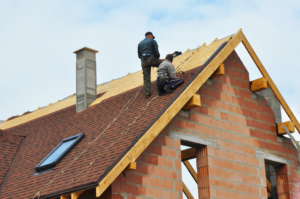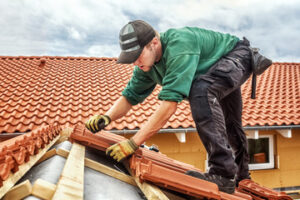The roof is the most vulnerable part of a house. It requires special construction methods. It must be strong enough to resist the weight of snow and rain, but not so strong that it becomes stiff or brittle.
It must also be able to drain water. The slope of the roof is measured by its pitch. A gable roof has two sloped sides that meet at a peak, called a ridge. Contact Arthur’s Roofing now!

A roof’s material is what gives it its primary protection from the elements. A wide variety of roofing materials exist, from natural products like thatch and slate to commercially produced materials such as tile, sheet metal and concrete shingles. Generally, these materials are placed on top of a secondary water-resistant layer known as underlayment.
Asphalt shingles are the classic roofing material, found on most modern homes. This affordable option is relatively easy to install and repair, and offers a range of styles to suit your home’s aesthetic. Concrete and clay tiles offer more durability than shingle roofing, but come at an increased cost. Nevertheless, they’re a good choice for hot climates and can last a lifetime when properly maintained.
Slate is a beautiful and durable roofing option that adds a sense of elegance to any home. Though expensive, it is long-lasting and can stand up to a variety of weather conditions, including high winds.
Wood shingles and shakes are a popular choice for homeowners seeking a more natural aesthetic. These natural roofing materials can be made from a number of trees, including pine, cypress, and red cedar. They’re biodegradable and highly energy efficient, adding value to your home. However, they’re not suitable for areas prone to moisture or wildfires and require regular maintenance.
Built-up roofs (BUR) are an older roofing type that was once a common choice for flat roofs. BUR is made up of multiple plies of either organic felt, polyester felt, or coated fiberglass felts that are laminated together with hot asphalt, coal tar pitch, or some other form of bituminous adhesive. BUR’s are fairly durable, but they have a low aesthetic appeal and can be difficult to inspect or repair.
Corrugated galvanised iron (also known as corro) is a very durable and affordable option for sheds and other outbuildings. It has wavy corrugations that resist bending and can be fitted with exposed fasteners. This type of metal roofing also comes in painted finishes to add beauty and style to your home’s exterior.
Installation
The roof is the main barrier to the weather and a vital part of the structure of any home or business. When a roof is installed properly, it can protect the interior from the elements for many years to come. The installation process begins by removing any existing roofing materials and preparing the decking for the new layer of shingles or other covering.
The vapor retarder, underlayment and felt paper are then put in place to protect the roof from moisture and wind. The shingle courses are laid starting at the bottom and working their way up the roof slope. Each course overlaps the last by a specific amount, which helps to offset breaks and joints in the shingles. After the shingles are in place, flashing is then used to protect the eaves, the roof valleys, wood stove pipes, certain vents and along hip roofs.
During the installation process, it is important that the contractor takes the proper safety precautions to ensure all workers are protected against falling debris. Resources available to help with this include a mobile app, safety plans and infographics, ladder safety, toolbox talks and videos.
Maintenance
A roof is a home’s primary barrier against the elements, shielding it from harsh sun damage, heavy rainstorms and other natural disasters. Performing regular maintenance can reduce costs and extend the life of your home’s roofing materials.
A comprehensive inspection should be performed regularly by trained roofing professionals, ideally on a biannual basis (once in spring and once in fall). This can help identify problems before they become serious, preventing costly repairs or replacements. In addition, a written roof maintenance program should be established, outlining routine inspections and maintenance activities.
Roof maintenance includes examining the condition of shingles for signs of wear and tear, assessing the caulking around chimneys, pipes, skylights and vents, ensuring the integrity of flashing and checking for the presence of moss and algae. These organisms trap moisture against the shingles, which can lead to material decay and potential leaks.
It is also important to keep the roof clear of debris, as this can block water flow to drain lines, resulting in localized ponding that can accelerate a roof’s degradation. Also, limbs that hang over a roof should be trimmed on an annual basis to ensure they are not damaged during high winds or other weather events.
Finally, it is a good idea to check the roof’s warranty on an annual basis. Oftentimes, manufacturers consider warranties null and void if preventive maintenance is not performed. It is also a good idea to understand what is covered and whether the warranty is transferable in the event of a sale or change in ownership of the property.
Repairs
Whether you’re experiencing isolated damage or the entire roof is showing signs of wear, timely repairs can save you the cost and hassle of replacement. In addition, a well-maintained roof will increase your home’s resale value, signaling to prospective buyers that you have proactively taken care of the property and invested in its long-term protection.
Professionals have the technical expertise to identify and assess roofing problems, determining the full scope of work needed for a durable solution. They’ll conduct thorough inspections of shingles, flashing, vents, and sections underneath damaged areas to find underlying issues that may be causing leaks or other damage. This enables them to fix these problems properly, sparing you costly repairs in the future.
They’re familiar with local building codes and regulations, ensuring all repair services comply with applicable laws and standards. This protects the structural integrity of your home and prevents insurance policies from voiding or shortening coverage due to improper workmanship.
Aside from addressing roofing defects, proper maintenance and timely repairs also help boost your home’s energy efficiency. Leaky roofs, for instance, allow conditioned air to escape and exterior air to infiltrate, forcing your HVAC system to work harder to maintain your desired temperature. Roof repairs can address these issues and improve your home’s insulation, helping you save on energy costs.
Professional roof repair companies offer a range of repair services, from shingle replacement to re-caulking, as well as gutter cleaning and installation. They’ll ensure that the repaired roof meets industry-standard standards and adheres to local building codes. In addition, they’ll use high-grade materials that will withstand exposure to the elements and last for years without deteriorating or cracking. They can also offer warranties on their work, offering peace of mind that you’re in good hands. The key is to choose a reputable company with a solid reputation and comprehensive portfolio of past projects. Make sure to ask about their license, insurance, and warranty before making a decision. A reputable company will be more than happy to provide you with this information. This is a reflection of their confidence in the quality of their services.
